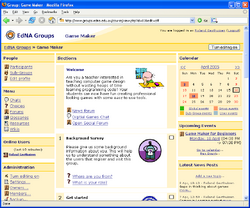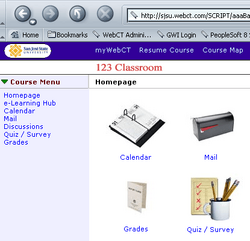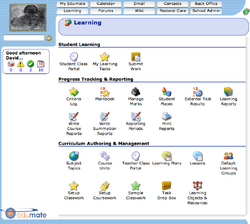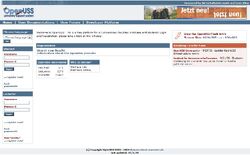Assessment |
Biopsychology |
Comparative |
Cognitive |
Developmental |
Language |
Individual differences |
Personality |
Philosophy |
Social |
Methods |
Statistics |
Clinical |
Educational |
Industrial |
Professional items |
World psychology |
Educational Psychology: Assessment · Issues · Theory & research · Techniques · Techniques X subject · Special Ed. · Pastoral

Moodle Learning Management System with a navigation system and online community building tools.
A Virtual learning environment (VLE) is a software system designed to facilitate teachers in the management of educational courses for their students, especially by helping teachers and learners with course administration. The system can often track the learners' progress, which can be monitored by both teachers and learners. While often thought of as primarily tools for distance education, they are most often used to supplement the face-to-face classroom.
These systems usually run on servers, to serve the course to students as internet pages.
Components of these systems usually include templates for content pages, discussion forums, chat, quizzes and exercises such as multiple-choice, true/false and one-word-answer. Teachers fill in these templates and then release them for learners to use. New features in these systems include blogs and RSS. Services generally provided include access control, provision of e-learning content, communication tools, and administration of the user groups.
Similar terms[]
It is a computer program that facilitates computerised learning or e-learning. Such e-learning systems are sometimes also called Learning Management System (LMS), Course Management System (CMS), Learning Content Management System (LCMS), Managed Learning Environment (MLE), Learning Support System (LSS) or Learning Platform (LP); it is education via computer-mediated communication (CMC) or Online Education.
A more correct term may be a virtual environment for learning, rather than virtual learning environment. This removes any ambiguities and identifies that it is the environment which is virtual and not the learning.
In the United States, CMS and LMS are the more common terms, however LMS is more frequently associated with software for managing corporate training programs rather than courses in traditional education institutions.
In the United Kingdom and many European countries the terms VLE and MLE are favoured, however it is important to realise that these are two very different things. A VLE can be considered a sub system of a MLE, whereas MLE refers to the wider infrastructure of information systems in an organisation that support and enable electronic learning on a wider scale. In fact a rather pedantic reading of the term MLE could be extended to encompass the physical environment in which learning takes place (i.e a school).
Becta, in the UK, have coined the term learning platform to cover both MLE and VLE as used in the schools sector. 'The term learning platform describes a broad range of ICT systems used to deliver and support learning. Through a learning platform, hardware, software and supporting services are brought together to enable more effective ways of working within and outside the classroom. At the heart of any learning platform is the concept of a personalised online learning space for the pupil. This space should offer teachers and pupils access to stored work, e-learning resources, communication and collaboration with peers, and the facility to track progress.' - DfES Making IT Personal leaflet, March 2006.
The renowned Woodhouse College is one notable user of the VLE system, where it is used extensively by both students and members of staff
Facilities[]
A VLE should make it possible for a course designer to present to students, through a single, consistent, and intuitive interface, all the components required for a course of education or training. Although logically it is not a requirement, in practice VLEs always make extensive use of computers and the Internet. A VLE should implement all the following elements:
- The syllabus for the course
- Administrative information including the location of sessions, details of pre-requisites and co-requisites, credit information, and how to get help
- A noticeboard for up-to-date course information
- Student registration and tracking facilities, if necessary with payment options
- Basic teaching materials. These may be the complete content of the course, if the VLE is being used in a distance learning context, or copies of visual aids used in lectures or other classes where it is being used to support a campus-based course.
- Additional resources, including reading materials, and links to outside resources in libraries and on the Internet.

WebCT Learning Management System with a navigation menu and icons giving access to automated tools and content pages.
- Self-assessment quizzes which can be scored automatically
- Formal assessment procedures
- Electronic communication support including e-mail, threaded discussions and a chat room, with or without a moderator
- Differential access rights for instructors and students

Edumate Student Learning and Management System showing the main learning interface.
- Production of documentation and statistics on the course in the format required for institutional administration and quality control
- All these facilities should be capable of being hyperlinked together
- Easy authoring tools for creating the necessary documents including the insertion of hyperlinks - though it is acceptable (arguably, preferable) for the VLE to be designed so that standard word processors or other office software can be used for authoring.
In addition, the VLE should be capable of supporting numerous courses, so that students and instructors in a given institution (and, indeed, across institutions) experience a consistent interface when moving from one course to another.
Popularity[]

Open University Support System
Universities and other institutions of higher education are increasingly turning to VLEs in order to:
- Economise on the time of teaching staff, especially when they are also involved in research and administration. The extent of the economy over traditional "talk-and-chalk" teaching is not yet clear, but using a VLE almost certainly absorbs less instructor time (and requires less expertise, while producing a more professional result) than creating a home-grown website for a course. (Many users of VLE's would dispute the above statement.)
- Provide a service for students who increasingly look to the internet as the natural medium for finding information and resources.
- Ensure that quality control requirements are met by providing a standard vehicle for collecting the required information
- Facilitate the integration of distance and campus-based learning. or of learning on different campuses.
In the UK 11-16 schools are being encouraged to make use of Learning Platforms. The DfES in the UK government has published an eStrategy outlining priorities that include every learner in schools having access to an online learning space and e-portfolio.
Transferring course content[]
Most VLEs support Shareable Content Object Reference Model (SCORM) as a standard way to upload, launch and track courses. There are no commonly used standards that define how the learner's performance within a course should be transferred from one VLE to another.
Some institutions have attempted to combat this problem by agreeing in collaboratives to share common platforms. Use of open source VLEs such as Moodle have more recently enabled institutions to share content more easily. For the schools sector in the UK the DfES via Becta has defined a Learning Platform "conformance framework" to encourage interoperability.
Systems available[]
For those wishing to deliver e-learning there are many free open source and proprietary VLEs available for use. On-demand e-learning services are also a popular choice because they can be deployed in minutes and don't require instructors & institutions to run their own servers.
Many VLEs are placed on a web server. In a typical VLE there are one or more programs or languages that provides the user (Teacher-Student) interface, and which interacts with a database. For example, a VLE might use PHP as its web language/program, with MySQL as a database.
VLEs are increasingly found in new niches. These include new emerging technologies, as well as specialized markets. A VLE can be deployed on a USB drive as a child, which synchronizes from time to time with its web based parent. VLEs can be used for training or in something as specialized as to meet ISO 9000 certification requirements.
List of some Virtual Learning Environments[]
- .LRN
- ANGEL Learning
- Blackboard
- Bodington
- ClassCentral
- Claroline
- Desire2Learn
- Digitalbrain
- Dokeos
- eCollege
- Edumate
- FirstClass
- ILIAS
- LON-CAPA
- Moodle
- OLAT
- Sakai Project
- Scholar360
- WebCT
- xMentor
See also[]
- History of virtual learning environments
- Content management framework
- E-learning
- Computer-assisted language learning
- Advanced Distributed Learning
- Becta
References[]
- Morgan, G. (2003). Faculty Use of Course Management Systems. 2, Retrieved November 27, 2005, from http://www.educause.edu/ir/library/pdf/ers0302/rs/ers0302w.pdf
- Paulsen, M. F. 2003. Online Education and Learning Management Systems - Global Elearning in a Scandinavian Perspective. Oslo: NKI Forlaget.
External links[]
- LMS Options and Comparisons Wiki based comparison of major VLEs
- EduTools: COURSE MANAGEMENT SYSTEMS: Compare Products
- LMSNews Reviews of Open Source LMS
cs:Learning Management System de:Lernplattform fr:LMS nl:Elektronische leeromgeving no:Læringsplattform fi:Oppimisalusta sv:Lärplattform
| This page uses Creative Commons Licensed content from Wikipedia (view authors). |